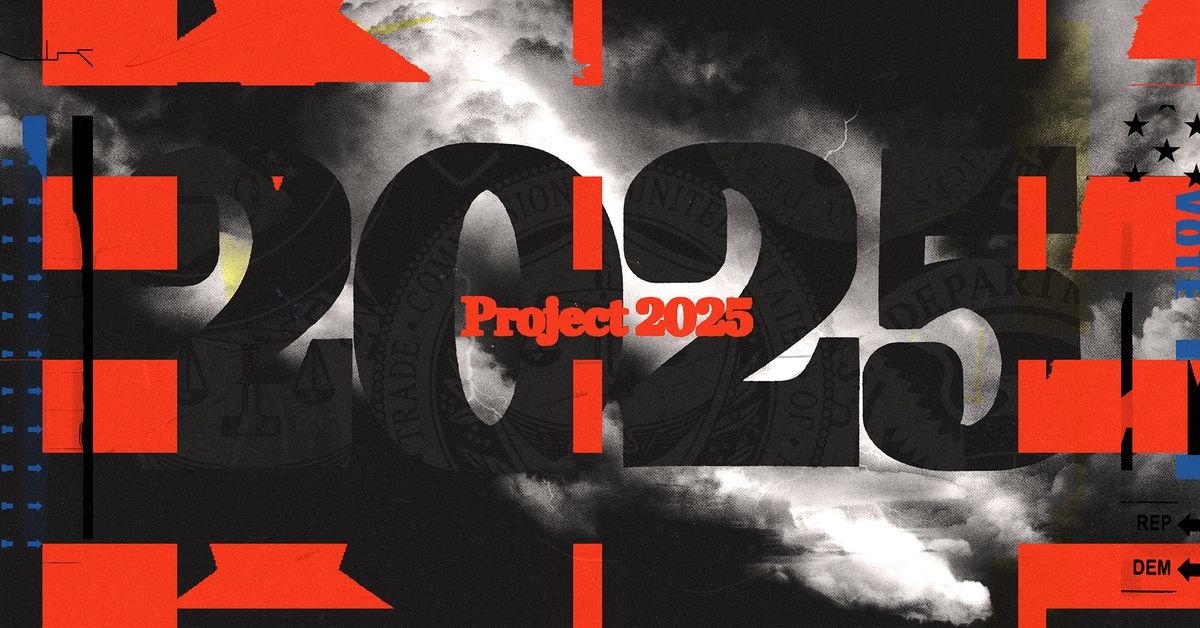For the better part of this year, Project 2025 has been a catchall among Democrats for the threat former President Donald Trump poses to American society. The more than 900-page Mandate for Leadership, crafted by conservative think tank the Heritage Foundation, is a sprawling and often contradictory mix of ideas from more than 100 organizations. It’s tied together not by unified policy predictions but by a series of preoccupations: China; “wokeness”; climate denialism; and a commitment to gutting or abolishing federal agencies. It includes plans that would remake America’s approach to technology, but like many things in the document, its authors can’t exactly agree on how.
Technology
The grievance-driven blueprint for the next Trump administration

Trump has attempted to distance himself from the policy plan, but it’s tied to him by numerous threads. His running mate, JD Vance, is friends with Kevin Roberts, the president of the Heritage Foundation, and Vance even wrote the introduction to Roberts’ forthcoming book, Dawn’s Early Light. (The book’s publication, initially slated for September, was postponed until after the election.) And some of Project 2025’s chapters were written by Trump’s own former administration officials, including FCC commissioner Brendan Carr and Department of Homeland Security official Ken Cuccinelli.
If Trump is elected, it’s highly likely that some of Project 2025’s ideas would be implemented — we just don’t know which ones. The most provocative proposals, like banning pornography, are prominently highlighted but never explained. Authors, in turn, recommend fighting and embracing tech companies. “I don’t think I’ve encountered a single person in America who agrees with 100 percent,” Roberts said at the Reboot Conference in San Francisco in September. “It’s like the menu at the Cheesecake Factory.”
Much of what’s on the menu is notably less delicious. We’re not going to break down every piece of Project 2025 here — you can find more general guides at CBS News, which showed how many of Project 2025’s policy recommendations match Trump’s own; ProPublica, which obtained secret training videos created for Project 2025’s Presidential Administration Academy; and The New York Times, which interviewed several former Trump officials involved in the creation of Project 2025. Instead, we’re taking a look at how its recommendations would affect tech at every level, from how companies can hire foreign workers to the social media platforms we use every day.
Though there are some contradictions between and within chapters — signs of fissures or points of contention among the dozens of participating organizations — Project 2025 does, in the end, amount to a coherent vision. The document calls for a radical expansion of government power to punish conservatives’ enemies in tech, oust potential dissenters within the federal bureaucracy, and enforce right-wing wish list items like mass deportations and a national abortion ban. All of this would be combined with mass deregulation and the defunding of social services and federal agencies that contribute to the public welfare. Project 2025’s authors want small government for social goods — but big government for retribution.
Federal Trade Commission
Authored by: Adam Candeub, a professor of law at Michigan State University. Candeub served as the acting assistant secretary of commerce for telecommunications and information under Trump. From 2020 to 2021, he was the deputy associate attorney general in Trump’s Department of Justice.
Project 2025’s FTC guidelines are perhaps the clearest example of conservative ambivalence toward tech. The section doesn’t actually offer a set of policy proposals. Instead, it outlines two diametrically opposed approaches: one where the Trump administration fiercely enforces antitrust law to break up monopolies; and another where it does barely anything at all.
In the enforcement route, Project 2025 suggests using the FTC to rein in major corporations, especially big tech companies. It puts forward the European Union’s “less friendly regulatory environment” as a good model, possibly referring to EU laws like the Digital Markets Act, which have forced tech companies to make major hardware and software changes to their products. It encourages the FTC to partner with state attorneys general to scrutinize or block hospital, supermarket, and big tech mergers. And it recommends that the FTC look into whether social media platforms’ advertising to and contract-making with children constitute unfair trade practices.
While there’s overlap with Democratic antitrust priorities here, there’s also a focus on clearly partisan concerns. The chapter suggests investigating whether social media platforms censored political speech in collusion with the government, following up on probes by the Republican-led House of Representatives and Republican state attorneys general. (Hunter Biden’s laptop, unsurprisingly, gets a mention.) You’ll also see references to issues like the “de-banking” of controversial figures, which the Trump family has cited as an inspiration for its mysterious crypto platform. “We are witnessing in today’s markets the use of economic power — often market and perhaps even monopoly power — to undermine democratic institutions and civil society,” the chapter claims.
Each of these points is contradicted by a long-standing conservative counterpoint: the government should let the market regulate itself. If the FTC regulates how children use internet platforms, for example, it could undermine conservatives’ calls for “parental empowerment on education or vaccines.” Expanding cooperation between the FTC and state attorneys general could “tie middle America to big progressive government.”
Ultimately, though, the chapter seems to favor intervention. Conservatives “cannot unilaterally disarm and fail to use the power of government to further a conservative agenda,” it warns, even if their goal is to do away with the regulatory state.
Federal Communications Commission
Authored by: Brendan Carr, a member of the Federal Communications Commission who was appointed by Trump in 2017.
Much of this chapter focuses on “reining in” major tech companies. Carr proposes a host of policies, including eliminating certain immunities under Section 230 of the Communications Decency Act and “clarifying” that Section 230’s key 26 words should only be used in cases about platforms failing to remove illegal material posted by users, not as a broader shield for moderation decisions.
Carr’s real concern is with social media platforms’ alleged suppression of conservative speech. The chapter suggests requiring “Big Tech” to follow net neutrality-like rules similar to those for broadband providers, like disclosure on practices such as blocking and prioritizing content. Platforms should also be required to “offer a transparent appeals process” when user content is taken down.
The chapter also suggests that the FCC regulatory power should be expanded with “fundamental Section 230 reforms” that let it regulate how online platforms moderate content — or, in Carr’s words, “no longer have carte blanche to censor protected speech.” Carr describes Texas’ HB 20 — the law that forbids platforms from removing, demonetizing, or downlinking posts based on “viewpoint,” which set the stage for NetChoice v. Paxton — as a possible model for federal legislation.
As companies must stop “censoring” conservative speech, they’re supposed to restrict children from accessing certain social media platforms. Carr quickly notes that these views “are not shared uniformly by all conservatives,” but as is the case in other chapters, the notion of expanding government powers to punish right-wing opponents ends up winning out over a more laissez-faire approach.
Congress should also require big tech to pay into the FCC’s Universal Service Fund, which helps fund broadband access in rural communities and is currently funded by broadband providers. It’s another example of Project 2025’s movement away from Reagan-era “small government” conservatives in favor of punishing disfavored targets with more regulation.
The chapter also recommends that the FCC and White House work together to free additional airwaves for commercial wireless services and generally do more to “move spectrum into the commercial marketplace.” Carr also recommends that the government build out internet infrastructure on federally owned land. The latter, however, can’t be accomplished by the FCC alone, and Carr notes that it would require working with the Bureau of Land Management and the Forest Service, among other agencies. The chapter also recommends that the FCC more quickly review and approve applications to launch new satellites, specifically for the purposes of supporting StarLink, Kuiper, and similar efforts.
And then there’s China. One of the primary recommendations is that the FCC “address TikTok’s threat to national security.” (Congress has, since the time the Mandate for Leadership was published, done just that by attempting to ban the app unless it divests from its parent company, ByteDance; whether the courts will let that happen remains to be seen.) Others include creating a more regular process to review entities “with ties to the CCP’s surveillance state” and stopping US entities “from indirectly contributing to China’s AI goals.”
Financial regulatory agencies
Authored by: David R. Burton, a senior research fellow in economic policy at the Heritage Foundation; and Robert Bowes, a senior adviser to the assistant secretary of the Department of Housing and Urban Development under Trump and former adviser to Trump aide Stephen Miller.
While other sections are often ambivalent about government regulation, this chapter straightforwardly suggests giving major concessions to cryptocurrency and loosening restrictions on who can invest in private companies.
Anyone who’s been following Trump’s attempts to court the crypto community should know what’s coming here. There are a host of recommendations for the Securities and Exchange Commission, which the authors say has “chosen regulation by enforcement” for cryptocurrency. The biggest change would be redefining digital assets as commodities, instead of securities, so they’re no longer regulated by the SEC.
The chapter also recommends making private capital raising less restrictive by changing a rule known as Regulation D. Under Regulation D, companies can raise unlimited funds for securities from an unlimited number of “accredited investors,” with no disclosure needed to the SEC. “Accredited investors” must currently have a salary of $200,000 (or $300,000 combined with their spouse) or a net worth of at least $1 million, excluding their primary residence. As of 2022, more than 24 million American households met these requirements. Project 2025 recommends broadening these qualifications or eliminating them altogether.
In practice, this would let anyone invest in any private company, not just — as the rule stands today — companies on the public market. To go public, companies have to meet certain requirements and file a registration statement with the SEC, where they’re subject to reporting requirements. In exchange, they currently get access to a much broader pool of potential investors. Eliminating the accredited investor requirement would effectively allow companies to skirt the requirements of going public — and the oversight they’re subject to afterward.
Department of Commerce
Authored by: Thomas F. Gilman, the director of ACLJ Action, a conservative organization affiliated with the American Center for Law and Justice. Gilman was the chief financial officer and assistant secretary for administration of the US Department of Commerce under Trump.
This sprawling chapter touches on nearly every major Project 2025 theme, from fears of China to the “alarm industry” of federal climate monitoring. Like practically every other section, it recommends expanding the federal government’s reach if it will advance conservative interests and doing away with any agencies that don’t.
In keeping with the goal of dismantling federal bureaucracies, this chapter suggests doing away with the National Oceanic and Atmospheric Administration (NOAA), which it says should be privatized or placed under the control of states and territories. Other agencies, like the National Weather Service (NWS) and Office of Oceanic and Atmospheric Research, would be severely downsized. (In a statement provided to the Los Angeles Times, Steven R. Smith, the CEO of AccuWeather — which Project 2025 suggested could replace the NWS — said AccuWeather’s forecast engine partly relies on NOAA data.) These agencies provide the data used in weather forecasts accessed by millions of Americans each day and also give the public crucial information about impending hurricanes, heatwaves, and other natural disasters and extreme weather events.
The Republican libertarian wing may get its goal of privatizing federal agencies, but most of this chapter argues for more — not less — government interference in the market. Noting that China has made significant advances in semiconductor design, aerospace technologies, and other crucial industries, it recommends new rules to prevent tech transfer to foreign adversaries. It also suggests an executive order expanding the Export Control Reform Act of 2018 to restrict exports of Americans’ data. And it opposes intellectual property waivers for “cutting-edge technologies” like covid-19 vaccines — which an earlier chapter says the Centers for Disease Control and Prevention shouldn’t encourage people to get — through international agreements. These waivers, which were hotly debated for years following the onset of the pandemic, give low- and middle-income countries access to life-saving immunizations, though advocates say more needs to be done to achieve global vaccine equity.
The chapter also suggests adding certain app providers — including WeChat, TikTok, and TikTok’s parent company, ByteDance — to the entity list, which would prevent the apps from issuing program updates in the US, effectively making them nonoperational. The Heritage Foundation apparently didn’t get the memo that Trump loves TikTok now.
Department of Transportation
Authored by: Diana Furchtgott-Roth, director of the Heritage Foundation’s Center for Energy, Climate, and Environment.
Unlike other chapters that are openly antagonistic toward tech companies, this chapter suggests partnering with the private sector to “revolutionize travel.” There’s an emphasis on private transportation over public transportation — not just in terms of opposing government funding for mass transit but also supporting ridehailing apps, self-driving vehicles, and micromobility, which only gets a passing mention in the chapter but likely refers to e-bikes and electric scooters.
Current policies, the document says, “strangle the development of new technologies” like drones. Instead, the DOT should encourage the use of small aircraft for air taxis or for quiet vertical flights. It should also push for a shift to digital or remote control towers for planes, letting flights be managed “anywhere from anywhere.”
Department of the Treasury
Authored by: William L. Walton, a trustee of the Heritage Foundation and the founder and chair of the private equity firm Rappahannock Ventures LLC; Stephen Moore, a visiting fellow in economics at the Heritage Foundation; and David R. Burton, a senior research fellow in economic policy at the Heritage Foundation.
Under Project 2025, the US would effectively abandon its commitment to stopping climate change. The chapter suggests getting rid of the department’s Climate Hub office and withdrawing from international climate change agreements, including the Paris agreement and the United Nations Framework Convention on Climate Change. Instead of focusing on clean energy or climate change-resilient infrastructure, the chapter suggests that the government should invest in domestic energy, especially oil and gas.
Like several other sections, this chapter takes aim at “wokeness” and diversity, equity, and inclusion (DEI) programs. As part of Project 2025’s plan to gut the federal workforce, it suggests identifying all Treasury officials who have participated in DEI initiatives, publishing their communications about DEI, and firing anyone who participated in DEI initiatives “without objecting on constitutional or moral grounds.”
Department of Health and Human Services
Authored by: Roger Severino, a vice president at the Heritage Foundation and former director of its DeVos Center for Religion and Civil Society, who served as the director of the HHS’s Office of Civil Rights under Trump.
The bottom line: Project 2025 would limit the government’s ability to do basic health governance while setting up a surveillance state for pet conservative issues like abortion and gender-affirming care for trans people.
Much of the HHS chapter focuses on the Centers for Disease Control and Prevention’s response to covid-19, which the author characterizes as near totalitarian. The chapter recommends barring the CDC from saying that children should be masked or vaccinated against any illness and says that the CDC should be investigated for “colluding with Big Tech to censor dissenting opinions during Covid.” The author also suggests moving several CDC programs — including the Clinical Immunization Safety Assessment project, which researches vaccine safety — to the Food and Drug Administration.
Unsurprisingly, abortion would be severely restricted. Under Project 2025, the FDA would reverse the approval of pills that facilitate medication abortions, which the document calls the “single greatest threat to unborn children.” The FDA would also eliminate policies allowing people to order abortion pills by mail or online. As the CDC would stop encouraging vaccinations — which some conservatives believe infringe on bodily autonomy — the agency would increase its surveillance and recordkeeping of abortions and maternal mortality. This includes a recommendation that the HHS “use every available tool, including the cutting of funds” to force states to report “exactly how many abortions take place within its borders.”
A separate study, through the National Institutes of Health, is recommended to investigate the “short-term and long-term negative effects of cross-sex interventions,” i.e., gender-affirming care. The report also recommends using AI to detect Medicaid fraud, which costs the US an estimated $100 billion a year and is typically perpetrated by healthcare providers, not individual beneficiaries of public healthcare.
Department of Homeland Security
Authored by: Ken Cuccinelli, who served in various capacities under Trump, including as the director of US Citizenship and Immigration Services and, later, the “senior official performing the duties of the Deputy Secretary of Homeland Security.”
Perhaps counterintuitively given Republicans’ laser focus on the US border, Project 2025 recommends abolishing the Department of Homeland Security. The goal, though, is to replace it with the Border Security and Immigration Agency, a new, more draconian, and less accountable immigration enforcement apparatus.
The Transportation Security Administration (TSA) would be privatized, and the Coast Guard would be moved to either the Department of Defense or the Department of Justice. Dismantling the DHS almost certainly won’t happen — it would require an act of Congress, and lawmakers haven’t passed an immigration bill in decades.
Project 2025 doesn’t just recommend more stringent restrictions on unauthorized immigration; it also lays out a vision of severely restricted legal immigration. It recommends scrapping the family-based immigration system that has been in place since 1965 and replacing it with a “merit-based system that rewards high-skilled aliens.” Other suggestions include eliminating the diversity visa lottery and altering the work visa system. This, too, would largely require congressional action.
As it prioritizes “merit-based” immigration to the US, the chapter proposes limiting foreign students’ ability to study here. In a move that (unlike much of this chapter) could be accomplished through executive action, it proposes ending what it calls Immigration and Customs Enforcement’s (ICE) “cozy deference to educational institutions,” i.e., the issuing of student visas to most foreign students admitted to US universities. It also calls to “eliminate or significantly reduce the number of visas issued to foreign students from enemy nations” — implicitly, China.
Intelligence community
Authored by: Dustin J. Carmack, Meta’s director of public policy for the Southern and Southeastern US. Carmack, a former research fellow at the Heritage Foundation, was the chief of staff for the Office of the Director of National Intelligence under Trump from 2020 to 2021.
Concerns about China are far more explicit in this chapter, which looks at the “vast, intricate bureaucracy of intelligence agencies within the federal government.” The chapter raises the threat of Chinese (and to a lesser extent, Russian) espionage, online influence campaigns, and “legitimate businesses serving as collection platforms,” a possible allusion to TikTok. The Mandate for Leadership recommends amending Executive Order 12333 — which was signed by President Ronald Reagan in 1981 and, among other things, authorizes mass data collection for intelligence purposes to address the threats the US and its allies face “in cyberspace.”
But the chapter also claims intelligence agencies have dedicated far too much time to surveilling the former president, which allegedly proves a “shocking extent of politicization” among the agencies and the officials who lead them. (Its evidence includes the letter signed by 51 former intelligence officials ahead of the 2020 US presidential election claiming that the story about Hunter Biden’s laptop was likely a Russian information operation.) The author calls for an investigation into “past politicization and abuses of intelligence information.”
The chapter also recommends that Section 702 of the Foreign Intelligence Surveillance Act (FISA) — the controversial law allowing warrantless wiretapping that was reauthorized earlier this year — be reformed with “strong provisions to protect against partisanship,” pointing to the use of FISA to surveil former Trump campaign associate Carter Page as part of the FBI’s investigation into Trump’s ties to Russia. There is little mention of how these vast surveillance powers affect regular people. In fact, the chapter notes that an independent review found that Section 702 surveillance powers were “not abused,” though it does recommend that Congress review further reports to determine whether any FISA reforms are needed.
Buried amid all these claims, it also recommends the Department of Defense examine the possibility of joint satellite and space programs with “potential allied nations” to counter the threat posed by Russia and China. Additionally, it suggests agencies spy on the space programs of foreign adversaries and collect more data on adversaries’ potential threats to US space programs.
Media agencies
Authored by: Mora Namdar, a former State Department official who worked as a senior policy adviser and acting assistant secretary of state in consular affairs under Trump; and Mike Gonzalez, a former journalist and current senior fellow at the Heritage Foundation.
These agencies aren’t as consequential as juggernauts like the FTC, but the usual slash-and-burn recommendations apply. Project 2025 encourages undercutting the Open Technology Fund, a subagency within the US Agency for Global Media dedicated to protecting free speech around the world that has funded open-source projects like Signal. It calls the OTF a “wasteful and redundant boondoggle” that makes “small, insubstantial donations to much larger messaging applications and technology to bolster its unsubstantiated claims” and — contra its name and stated mission — suggests it fund closed-source technology instead.
The chapter also notes that there is “vast concern” about the vulnerability of undersea cable trunks that power the internet and says that major global conflict could cause widespread damage to these cables, potentially leading to long-lasting power outages. There is no mention of what can be done to prevent this, though the chapter does say that the US Agency for Global Media’s shortwave radio capabilities could help carry broadcasts and maintain communication in areas where online traffic is limited or restricted.
Technology
The Beats Solo 4 headphones are half off

Right now Amazon is offering a pretty good deal on the Beats Solo 4 wireless headphones that’s worth a look. Wireless headphones can be a great accessory to have if you listen to a lot of music on the go. Quite simply because it’s more convenient to have no wires tying you down while you’re out and about. You don’t have to worry about cables going to and from your phone getting caught on stuff.
Normally these headphones would cost $199.99 if they were available at their full retail price. However, Amazon currently has them on sale for just $99.99. That’s half off, and the lowest price for these headphones to date. That being said, they have been discounted to $99.99 once before, back in early October.

Now worth noting is that Amazon has four colors fo the Beat Solo 4 and all four of them are on sale for the $99.99 price. This includes Cloud Pink, Slate Blue, Matte Black, and Black/Gold. As far as wireless headphones go the Beat Solo 4 have a lot to offer. Not the least of which is the 50-hour battery life. This is a pretty long time for battery life on a single charge and gives you plenty of listening time.
On top of that, when the battery does die, there’s the “Fast Fuel” feature that gets you up to 5 hours of listening time with just 10 minutes on the charger. One of the other really awesome features is the spatial audio capability. You don’t have to enable this, but it makes a huge difference in how content sounds, and it’s well worth it in our opinion. These headphones are also compatible with both iOS and Android. So it doesn’t matter which platform you use.
Technology
Early Black Friday deals from Amazon include the Echo Show 5 for only $50

It may still be October, but Black Friday deals have already started coming down the pike. Case in point? The Amazon Echo Show 5 smart display . This early Black Friday deal knocks 44 percent off the price, bringing it down to what we saw on Prime Day.
This sale is for the most recent version of the device, which was originally released last year. The 3rd Gen Echo Show 5 easily made our list of the . We said that “it doubles as a stellar alarm clock.” There’s an ambient light sensor that automatically adjusts the brightness of the screen, a tap-to-snooze feature and a sunrise alarm.
While others may decry the diminutive 5.5-inch screen size, when compared to rivals, we actually found it to be useful. The small form factor allows the display to easily squeeze on a busy nightstand or a dresser.
The Show 5 does have a camera, which is great for video calls but not so great for privacy. After all, this thing was made to sit by your bedside. It does, however, ship with a physical camera cover for the privacy-conscious. The only other downside is that the sound quality here isn’t quite as robust as the larger models. Still, this is a whole lot of smart display for $50.
Follow @EngadgetDeals on Twitter and subscribe to the Engadget Deals newsletter for the latest tech deals and buying advice.
Technology
Lamborghini and Animoca’s Motorverse tap Base blockchain for in-game assets

Lamborghini and Animoca’s Web3 racing game Motorverse are tapping Coinbase’s Base blockchain to deploy interoperable Revuelto in-game assets.
Automobili Lamborghini and Animoca’s Motoverse said they are taking their collectible game efforts to the next level, selecting Base as their blockchain platform of choice to mint exclusive Revuelto collectibles.
This aligns with Lamborghini’s introduction of Fast ForWorld, its brand-new digital ecosystem created in collaboration with Motoverse, Animoca Brands’ motorsports-focused project. Together, they’re driving innovation at the intersection of luxury and motorsports—bringing Lamborghini fans and collectors a unique, immersive digital experience.
The Revuelto launch represents a big moment for Lamborghini’s immersive digital ecosystem Fast ForWorld, developed in partnership with Motorverse. In its first version, which will go live on November 7, 2024, Fast ForWorld will feature a 3D wallet to store digital items and interoperable features, allowing users to interact and play with their cars across multiple titles in the future.
Each digital Revuelto mirrors its physical counterpart with unique characteristics, serving as both a collectible and the gateway to Fast ForWorld. The platform functions as a comprehensive digital hub where enthusiasts can showcase their vehicles, participate in exclusive experiences, and engage with the broader Lamborghini ecosystem.
Revuelto collectors will receive a Fast ForWorld Genesis Capsule, unlocking premium benefits including race tickets, real-world experiences, engagement points, and exclusive Lamborghini digital merchandise.
Will Griffiths, general manager of the Motorverse, said in a statement, “We’re so excited to announce this collaboration with Lamborghini. We know users are committed to this name, and bringing their latest contribution into the digital landscape highlights what this space can do for both fans and brands. We expect this is the beginning of a much deeper relationship as the Motorverse evolves.”
The selection of Base as the minting blockchain leverages its industry-leading security, cost-efficiency, and performance. As Coinbase’s Layer 2 solution, Base has emerged as a premier platform for onchain applications, making it an ideal foundation for Lamborghini’s digital initiatives.
This development showcases the Motorverse’s vision for integrated digital experiences where collectibles enhance user engagement across the entire ecosystem while supporting beloved automotive brands. The Revuelto release marks the beginning of an expanded digital collection strategy.
Source link
Technology
Introducing the 2024 Startup Battlefield Top 20 Finalists at TechCrunch Disrupt

We can’t keep this secret any longer! The time has come to unveil this year’s Startup Battlefield Top 20 Finalists who will compete in a winner-takes-all pitch competition on the Disrupt Stage at TechCrunch Disrupt 2024.
TechCrunch editorial hand-selected 200 startups, out of thousands of applicants, to comprise the Startup Battlefield 200. This year, TechCrunch saw the highest number of applications from around the world and across many industries. Of the 200, 20 companies have been selected as finalists to battle it out on the Disrupt Stage for the $100,000 equity-free grand prize and the coveted Disrupt Cup. Less than 1% of applicants to the Startup Battlefield program are selected as a Top 20 Finalist, making it one of the most competitive startup programs in the industry.
As part of the Startup Battlefield 200, founders participate in a series of pre-event, virtual programming to help prepare them to pitch on the Disrupt Stage. In addition to extensive pitch coaching, this year’s programming included Founder Fireside Chats with legends like Kevin Ryan (AlleyCorp) and Marcelo Lebre (Remote), as well as VC panels with Sara Deshpande (Maven Ventures) and Ishani Thakur (Index Ventures).
This year’s Top 20 Finalists will follow in the footsteps of Startup Battlefield legends like DropBox, Discord, CloudFlare and Mint on the Disrupt Stage. With over 1,500 alumni having participated in the program, Startup Battlefield Alumni have collectively raised over $29 billion in funding with more than 200 successful exits.
The Startup Battlefield Top 20 Finalists were chosen for their potential for game-changing societal, environmental and financial impact. In addition to having ambitious visions, these startups demonstrated prospective early traction, strong founding teams, business model and market size in their applications. These companies are actively working to solve critical challenges in clean tech, SaaS, fintech, health tech, auto tech, entertainment, and manufacturing.
Starting today, the Top 20 Finalists will pitch and demo live on stage for six minutes followed by a six-minute Q&A with our expert panel of judges. These top-tier VC judges include folks like Navin Chaddha (Mayfield), Chris Farmer (SignalFire), Dayna Grayson (Construct Capital), Ann Miura-Ko (Floodgate) and Hans Tung (Notable Capital), just to name a few.
All 20 startups will pitch in semi-final showdowns on Monday and Tuesday and the top 5 finalists will be announced Tuesday evening. Those five companies will then pitch once more in the Battlefield Finals on Wednesday beginning at 11:30 a.m. and we will announce the winner at 4 p.m., all on the Disrupt Stage. You won’t want to miss it.
Now, the moment you have all been waiting for…. Here are the 2024 Startup Battlefield Top 20 Finalists:
Monday, October 28th, Disrupt Stage
Semi-Finals (Session 1): 10:35 a.m.–11:50 a.m.
NitroFix: Aims to reduce carbon footprints by optimizing ammonia production with zero emissions, relying solely on renewable electricity, water, and air.
ForestGuard: Dedicated to preventing wildfires with their solar-powered IoT devices and AI-assisted algorithms which allow them to detect fire hazards up to 80% earlier than traditional methods, reducing greenhouse gas emissions and improving air quality.
SpiralWave: A novel reactor that produces affordable e-methanol from flue gas or air and water in one step, eliminating captured CO2 and H2 feedstocks, without a catalyst.
Level Zero Health: Pioneering Continuous Hormone Monitoring with a simple patch device that you can wear on top of your arm for up to 2 weeks.
Solideon: Layers off-the-shelf robotics with proprietary software that creates multi-robotic, forward deployable micro-factories that are capable of 3D printing, post processing, assembling, and inspecting entire structures and vehicles without human intervention.
Semi-Finals (Session 2): 2:00 p.m.–3:15 p.m.
Advex AI: Helps the world’s largest manufacturers reduce costs and improve efficiency by providing highly reliable computer vision models in hours.
DGLegacy: Ensures that in the case of an unforeseen event, your assets won’t be lost and your loved ones would be able to claim their rightful ownership with a digital legacy planning and inheritance app.
VRTL: A virtual venue for entertainment organizations to deliver and scale in-person fan experiences to a remote, global audience, for greater lifetime values and data collection.
MabLab: Maker of 5-in-1, at-home rapid tests to screen for laced drugs and spiked drinks. Results delivered in under three minutes, potentially saving over 100,000 lives annually and preventing an additional 5 million hospitalizations every year.
Stitch3D: Offers a SaaS platform for hosting, processing, viewing, analyzing, and sharing large volumes of LIDAR point cloud data, all in a real-time collaborative 3D viewer.
Tuesday, October 29th, Disrupt Stage
Semi-Finals (Session 3): 10:05 a.m.–11:15 a.m.
HILOS: Unifies deep tech with sustainable craft to offer a software and manufacturing platform to design and launch 3D-printed footwear made locally, on-demand, without end-of-life waste.
CTGT: Removes barriers to production-ready AI, tailoring LLMs to company needs by eliminating unwanted content, enabling 10x faster AI deployment for critical applications like finance and healthcare.
luna: An AI-driven health and wellbeing companion for teens, so they can feel empowered to make informed decisions about their health and wellbeing as they move into adulthood.
Narada AI: A generative AI assistant that identifies tasks from conversations and executes them across enterprise tools using AI orchestration.
Salva Health: Julieta is a portable, AI-powered breast cancer detection device that eliminates barriers to early screening, ensuring access even in remote areas.
Semi-Finals (Session 4): 2:00 p.m.–3:15 p.m.
BANF: Ensures safe driving and optimizes fuel efficiency by 20% with their smart tire profile technology by providing real-time tire data, including pressure, temperature, wear, load, wheel alignment, and lug nut status.
ForceField: MARQ protects company, community & country data with tamper-proof badges. Patent-pending APIs defend against deepfake scams, fraud & breaches.
geCKo Materials: A bio-inspired Dry Adhesive that is ultra-strong, reusable, leaves no residue, and requires no force to detach. The product opens new applications in industrial automations, robotic gripping, space and defense.
Haptic: A B2B SaaS company creating a universal language through touch whose tactile technology empowers intuitive, safe navigation without visual or audio cues – enhancing accessibility and awareness for all.
MDC: Revolutionizing surgery with a novel robotic system that provides physicians direct access inside MRI scanners.
Wednesday, October 30th, Disrupt Stage
Alumni Update Panel: 11:15 a.m.–11:30 a.m.
Winner of Startup Battlefield 2023, BioticsAI is a clinical intelligence platform for prenatal health care utilizing machine learning to catch abnormalities in fetal ultrasound imagery, help doctors streamline their workloads by generating automated reports, and help with legal compliance to help reduce malpractice cases within the hospitals.
Winner of Startup Battlefield 2022, Minerva Lithium is a water treatment platform technology company leading the charge in sustainable Lithium Refining. Minerva Lithium selectively traps valuable minerals and other harmful pathogens from water.
2022 Startup Battlefield Runner-Up, Intropic Materials is imparting a favorable end-of-life at the beginning by embedding degrading enzymes directly inside plastics. Once activated, the enzymes trigger the plastic to rapidly and completely self-degrade into biodegradable or chemically recyclable small molecules.
Startup Battlefield Finals: 11:30 a.m.–12:50 p.m.
Winner Announced: 4:05 p.m – 4:20 p.m.
Haven’t snagged your ticket yet? It’s not too late! Join us at Disrupt 2024 to witness these outstanding companies pitch live on stage. Register here or when you arrive at the registration desk at Disrupt.
Technology
Apple put the Magic Mouse’s charging port on the bottom again

Apple’s new USB-C-equipped Magic Mouse somehow still has the charging port on the bottom. While Apple could have used the launch as an opportunity to move the charging port from the underside of the device — where the port has remained for nearly a decade, despite other updates to the mouse and being mocked for the decision — the port is still there.
This new $99 Magic Mouse means that, for the foreseeable future, Apple still thinks that the best way to charge your Magic Mouse is by flipping it over to plug it in, making it so you can’t use it. Why?
There have been other solutions to the ridiculous Magic Mouse charging situation. For example, my colleague Wes Davis wrote about an ergonomic grip for the Magic Mouse 2 that can charge the mouse via MagSafe. But Apple seemingly didn’t think that it needed to make a major change to where the charging port is, so you’ll once again have to turn it over to get some more juice.
Technology
Apple launches new iMac with M4 chips, first Macs with Apple Intelligence


After plenty of leaks and speculation, Apple has officially announced the latest iMac, equipped with both the M4 chip and Apple Intelligence – the first Mac device featuring the AI-based technology.
According to Apple, the M4 iMac is “1.7x faster for daily productivity, and up to 2.1x faster for demanding workflows like photo editing and gaming,” compared to the M1 iMac. Its 24-inch 4.5K Retina display has a new nano-texture glass option, and it’s also outfitted with a new 12MP Center Stage camera with Desk View, and up to four Thunderbolt 4 ports. It comes standard with 16GB of unified memory and is configurable up to 32GB
Pricing for the new M4 iMac starts at $1,299 and will launch on November 8, 2024.
This article is breaking news and will be updated with new information as it releases.
-

 Technology1 month ago
Technology1 month agoIs sharing your smartphone PIN part of a healthy relationship?
-

 Science & Environment1 month ago
Science & Environment1 month agoHow to unsnarl a tangle of threads, according to physics
-

 Science & Environment1 month ago
Science & Environment1 month agoHyperelastic gel is one of the stretchiest materials known to science
-

 Science & Environment1 month ago
Science & Environment1 month ago‘Running of the bulls’ festival crowds move like charged particles
-

 Science & Environment1 month ago
Science & Environment1 month agoMaxwell’s demon charges quantum batteries inside of a quantum computer
-

 Technology1 month ago
Technology1 month agoWould-be reality TV contestants ‘not looking real’
-

 Science & Environment1 month ago
Science & Environment1 month agoX-rays reveal half-billion-year-old insect ancestor
-

 Science & Environment1 month ago
Science & Environment1 month agoSunlight-trapping device can generate temperatures over 1000°C
-

 Technology4 weeks ago
Technology4 weeks agoUkraine is using AI to manage the removal of Russian landmines
-

 Science & Environment1 month ago
Science & Environment1 month agoLiquid crystals could improve quantum communication devices
-

 Science & Environment1 month ago
Science & Environment1 month agoPhysicists have worked out how to melt any material
-

 TV4 weeks ago
TV4 weeks agoসারাদেশে দিনব্যাপী বৃষ্টির পূর্বাভাস; সমুদ্রবন্দরে ৩ নম্বর সংকেত | Weather Today | Jamuna TV
-

 Technology3 weeks ago
Technology3 weeks agoSamsung Passkeys will work with Samsung’s smart home devices
-

 Science & Environment1 month ago
Science & Environment1 month agoQuantum ‘supersolid’ matter stirred using magnets
-

 Science & Environment1 month ago
Science & Environment1 month agoLaser helps turn an electron into a coil of mass and charge
-

 Football4 weeks ago
Football4 weeks agoRangers & Celtic ready for first SWPL derby showdown
-

 Sport4 weeks ago
Sport4 weeks agoBoxing: World champion Nick Ball set for Liverpool homecoming against Ronny Rios
-

 MMA3 weeks ago
MMA3 weeks ago‘Uncrowned queen’ Kayla Harrison tastes blood, wants UFC title run
-

 News3 weeks ago
News3 weeks agoMassive blasts in Beirut after renewed Israeli air strikes
-

 News3 weeks ago
News3 weeks ago▶ Hamas Spent $1B on Tunnels Instead of Investing in a Future for Gaza’s People
-

 News3 weeks ago
News3 weeks agoNavigating the News Void: Opportunities for Revitalization
-

 Science & Environment1 month ago
Science & Environment1 month agoA new kind of experiment at the Large Hadron Collider could unravel quantum reality
-

 Technology4 weeks ago
Technology4 weeks agoGmail gets redesigned summary cards with more data & features
-

 Football4 weeks ago
Football4 weeks agoWhy does Prince William support Aston Villa?
-

 News4 weeks ago
News4 weeks ago‘Blacks for Trump’ and Pennsylvania progressives play for undecided voters
-

 Sport3 weeks ago
Sport3 weeks agoAaron Ramsdale: Southampton goalkeeper left Arsenal for more game time
-

 MMA4 weeks ago
MMA4 weeks agoDana White’s Contender Series 74 recap, analysis, winner grades
-

 MMA4 weeks ago
MMA4 weeks agoPereira vs. Rountree prediction: Champ chases legend status
-

 Business3 weeks ago
Business3 weeks agoWhen to tip and when not to tip
-

 Technology1 month ago
Technology1 month agoRussia is building ground-based kamikaze robots out of old hoverboards
-

 Womens Workouts1 month ago
Womens Workouts1 month ago3 Day Full Body Women’s Dumbbell Only Workout
-

 Technology4 weeks ago
Technology4 weeks agoMicrophone made of atom-thick graphene could be used in smartphones
-

 Technology4 weeks ago
Technology4 weeks agoMusk faces SEC questions over X takeover
-

 Sport3 weeks ago
Sport3 weeks agoWales fall to second loss of WXV against Italy
-

 Technology4 weeks ago
Technology4 weeks agoEpic Games CEO Tim Sweeney renews blast at ‘gatekeeper’ platform owners
-

 Money3 weeks ago
Money3 weeks agoWetherspoons issues update on closures – see the full list of five still at risk and 26 gone for good
-

 Sport3 weeks ago
Sport3 weeks agoMan City ask for Premier League season to be DELAYED as Pep Guardiola escalates fixture pile-up row
-

 Science & Environment1 month ago
Science & Environment1 month agoWhy this is a golden age for life to thrive across the universe
-

 Science & Environment1 month ago
Science & Environment1 month agoQuantum forces used to automatically assemble tiny device
-

 Science & Environment1 month ago
Science & Environment1 month agoA slight curve helps rocks make the biggest splash
-

 Science & Environment1 month ago
Science & Environment1 month agoNuclear fusion experiment overcomes two key operating hurdles
-

 News1 month ago
News1 month ago▶️ Hamas in the West Bank: Rising Support and Deadly Attacks You Might Not Know About
-
Business4 weeks ago
DoJ accuses Donald Trump of ‘private criminal effort’ to overturn 2020 election
-

 News4 weeks ago
News4 weeks agoWoman who died of cancer ‘was misdiagnosed on phone call with GP’
-

 Technology4 weeks ago
Technology4 weeks agoMicrosoft just dropped Drasi, and it could change how we handle big data
-

 MMA3 weeks ago
MMA3 weeks agoKetlen Vieira vs. Kayla Harrison pick, start time, odds: UFC 307
-

 News4 weeks ago
News4 weeks agoCornell is about to deport a student over Palestine activism
-

 Sport4 weeks ago
Sport4 weeks ago2024 ICC Women’s T20 World Cup: Pakistan beat Sri Lanka
-

 Science & Environment1 month ago
Science & Environment1 month agoITER: Is the world’s biggest fusion experiment dead after new delay to 2035?
-

 Technology1 month ago
Technology1 month agoMeta has a major opportunity to win the AI hardware race
-

 Technology1 month ago
Technology1 month agoWhy Machines Learn: A clever primer makes sense of what makes AI possible
-

 News4 weeks ago
News4 weeks agoRwanda restricts funeral sizes following outbreak
-

 Sport4 weeks ago
Sport4 weeks agoChina Open: Carlos Alcaraz recovers to beat Jannik Sinner in dramatic final
-

 Sport4 weeks ago
Sport4 weeks agoSturm Graz: How Austrians ended Red Bull’s title dominance
-

 MMA3 weeks ago
MMA3 weeks ago‘I was fighting on automatic pilot’ at UFC 306
-

 Entertainment3 weeks ago
Entertainment3 weeks agoNew documentary explores actor Christopher Reeve’s life and legacy
-

 Technology4 weeks ago
Technology4 weeks agoThis AI video generator can melt, crush, blow up, or turn anything into cake
-
Business4 weeks ago
Sterling slides after Bailey says BoE could be ‘a bit more aggressive’ on rates
-

 News3 weeks ago
News3 weeks agoFamily plans to honor hurricane victim using logs from fallen tree that killed him
-

 Technology3 weeks ago
Technology3 weeks agoThe best budget robot vacuums for 2024
-

 Sport3 weeks ago
Sport3 weeks agoCoco Gauff stages superb comeback to reach China Open final
-

 Science & Environment1 month ago
Science & Environment1 month agoNerve fibres in the brain could generate quantum entanglement
-

 Science & Environment1 month ago
Science & Environment1 month agoTime travel sci-fi novel is a rip-roaringly good thought experiment
-

 Science & Environment1 month ago
Science & Environment1 month agoHow to wrap your mind around the real multiverse
-

 MMA4 weeks ago
MMA4 weeks agoJulianna Peña trashes Raquel Pennington’s behavior as champ
-

 News4 weeks ago
News4 weeks agoGerman Car Company Declares Bankruptcy – 200 Employees Lose Their Jobs
-

 Technology4 weeks ago
Technology4 weeks agoTexas is suing TikTok for allegedly violating its new child privacy law
-

 Technology3 weeks ago
Technology3 weeks agoCheck, Remote, and Gusto discuss the future of work at Disrupt 2024
-

 News3 weeks ago
News3 weeks agoHull KR 10-8 Warrington Wolves – Robins reach first Super League Grand Final
-
Business3 weeks ago
The search for Japan’s ‘lost’ art
-

 Business4 weeks ago
Business4 weeks agoStocks Tumble in Japan After Party’s Election of New Prime Minister
-
Business4 weeks ago
how UniCredit built its Commerzbank stake
-
Business4 weeks ago
Bank of England warns of ‘future stress’ from hedge fund bets against US Treasuries
-

 Business4 weeks ago
Business4 weeks agoChancellor Rachel Reeves says she needs to raise £20bn. How might she do it?
-

 News1 month ago
News1 month ago▶️ Media Bias: How They Spin Attack on Hezbollah and Ignore the Reality
-

 MMA4 weeks ago
MMA4 weeks agoKayla Harrison gets involved in nasty war of words with Julianna Pena and Ketlen Vieira
-

 Health & fitness4 weeks ago
Health & fitness4 weeks agoNHS surgeon who couldn’t find his scalpel cut patient’s chest open with the penknife he used to slice up his lunch
-
Business3 weeks ago
Head of UK Competition Appeal Tribunal to step down after rebuke for serious misconduct
-

 Technology3 weeks ago
Technology3 weeks agoThe best shows on Max (formerly HBO Max) right now
-

 Technology3 weeks ago
Technology3 weeks agoIf you’ve ever considered smart glasses, this Amazon deal is for you
-

 MMA3 weeks ago
MMA3 weeks ago‘Dirt decision’: Conor McGregor, pros react to Jose Aldo’s razor-thin loss at UFC 307
-

 Sport4 weeks ago
Sport4 weeks agoWorld’s sexiest referee Claudia Romani shows off incredible figure in animal print bikini on South Beach
-

 Football4 weeks ago
Football4 weeks agoSimo Valakari: New St Johnstone boss says Scotland special in his heart
-

 Technology4 weeks ago
Technology4 weeks agoJ.B. Hunt and UP.Labs launch venture lab to build logistics startups
-

 Technology4 weeks ago
Technology4 weeks agoApple iPhone 16 Plus vs Samsung Galaxy S24+
-
Politics4 weeks ago
Rosie Duffield’s savage departure raises difficult questions for Keir Starmer. He’d be foolish to ignore them | Gaby Hinsliff
-

 MMA3 weeks ago
MMA3 weeks agoUFC 307 preview show: Will Alex Pereira’s wild ride continue, or does Khalil Rountree shock the world?
-

 Business3 weeks ago
Business3 weeks agoStark difference in UK and Ireland’s budgets
-

 Money3 weeks ago
Money3 weeks agoPub selling Britain’s ‘CHEAPEST’ pints for just £2.60 – but you’ll have to follow super-strict rules to get in
-

 MMA3 weeks ago
MMA3 weeks agoPereira vs. Rountree preview show live stream
-

 Science & Environment4 weeks ago
Science & Environment4 weeks agoMarkets watch for dangers of further escalation
-

 Technology4 weeks ago
Technology4 weeks agoAmazon’s Ring just doubled the price of its alarm monitoring service for grandfathered customers
-

 Technology3 weeks ago
Technology3 weeks agoOpenAI secured more billions, but there’s still capital left for other startups
-

 Sport4 weeks ago
Sport4 weeks agoPremiership Women’s Rugby: Exeter Chiefs boss unhappy with WXV clash
-

 News1 month ago
News1 month agoOur millionaire neighbour blocks us from using public footpath & screams at us in street.. it’s like living in a WARZONE – WordupNews
-

 MMA4 weeks ago
MMA4 weeks agoAlex Pereira faces ‘trap game’ vs. Khalil Rountree
-
Business4 weeks ago
Top shale boss says US ‘unusually vulnerable’ to Middle East oil shock
-

 News4 weeks ago
News4 weeks agoLiverpool secure win over Bologna on a night that shows this format might work
-

 Money3 weeks ago
Money3 weeks agoAll the key dates for Christmas to save you money including £4 chocs and 25% off Disney
-

 Technology3 weeks ago
Technology3 weeks agoLG C4 OLED smart TVs hit record-low prices ahead of Prime Day

You must be logged in to post a comment Login